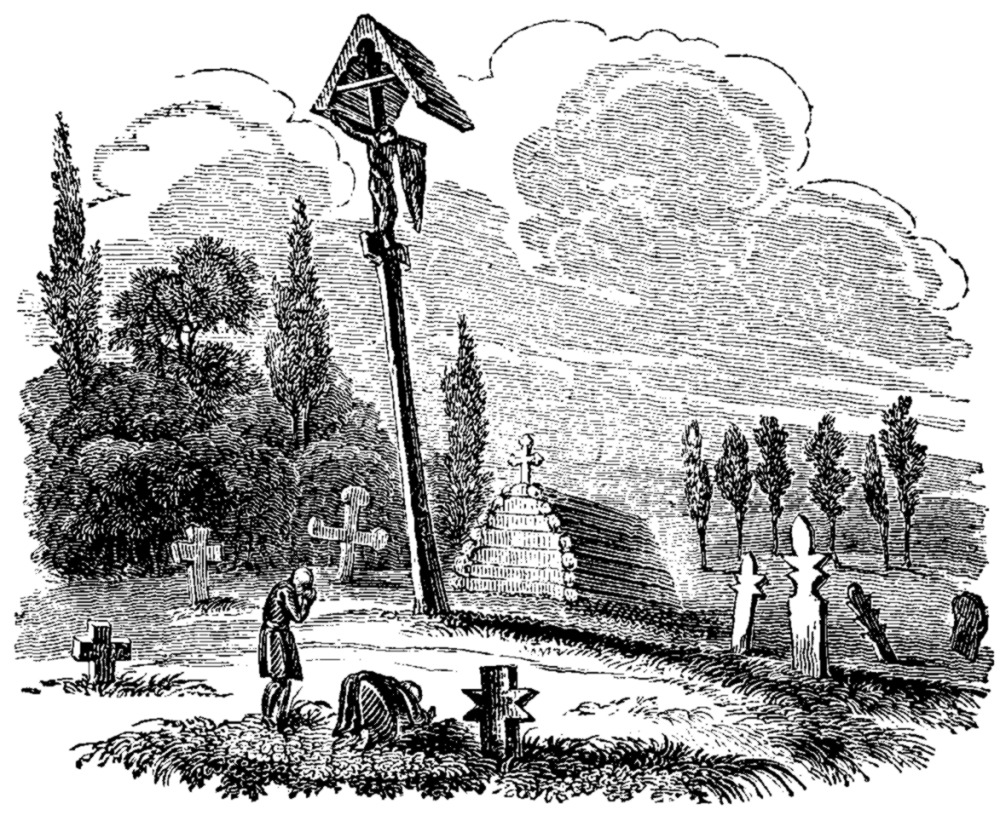The June 25, 1835 issue of the London-based The Mirror of Literature, Amusement, and Instruction contained in its pages a beautiful description of a cemetery on Tchernigoff – then part of the Russian Empire and now part of Ukraine (and more commonly known in English as Chernihiv). The description came courtesy of John Thomas James’s 1819 Journal of a Tour in Germany, Sweden, Russia, Poland, in 1813 and 1814. In this post, we will feature the illustration that appeared in The Mirror and the original description from James’s travel book.
Before continuing, we have discussed articles from The Mirror in prior posts.
Woodcut of an 1813-1814 Cemetery at Tchernigoff
The following image of the government cemetery at Tchernigoff.

According to The Mirror, the image was supplied by James’ book. However, while I did find the passage in James’ travel book discussing the cemetery at Tchernigoff, the version I relied on is missing the image.
Finding John Thomas James’ Tchernigoff Cemetery Passage
The Mirror excerpted part of John Thomas James’ description of the cemetery at Tchernigoff. I was able to find the original passage in a 1919 edition of his Journal at the Internet Archive. We will refer to pages 357 and 358 of the book. Note that page 359 appears to have a missing image. I venture that the missing image is the one that appears in The Mirror, and that it had been attached to the book and lost at some point prior to the book’s being scanned.
Assuming that I am correct about the missing image, I suppose that between our 1831 magazine and the 1819 copy of the book on Internet Archive, we managed to piece the original book back together.
John Thomas James on the Cemetery at Tchernigoff
Below, I reprint James’ passage about the cemetery in its entirey.
The grounds marked out by these tumuli were selected as favourite places of interment by natives at the present day: often being planted around with trees, and studded thick with wooden crosses, oratories, and other permanent marks of reverence. The general appearance of piety with which they are kept up, their sequestered situation apart from any town, the profound veneration with which they are saluted by the natives, added to the dark and sepulchral shade of the old groves, lent them an interest with which the tinsel ornaments of more gorgeous cemeteries can no degree compare.
John Thomas James on a cemetery at Tchernigoff
Combined with the image, James’ description paints a beautiful portrait of the cemetery at Tchernigoff. Graves were marked with burial mounds and crosses. The cemetery was secluded from nearby towns both by its location and by the surrounding foliage. The cemetery was in no way ostentatious, but the efforts of the natives to maintain it, combined with their piety and sentiments, let the cemetery, in James’ view, “an interest” with which more ornamented cemeteries could not compare.
Some Notes on the “Tchernigoff” Spelling
As I noted at the top, “Tchernigoff” seems to be an uncommon English spelling for the city of interest these days. For example, Wikipedia’s English entry for the city is spelled Chernihiv, and as of June 24, 2021, “Tchernigoff” is not included as one of the alternate spellings (although “Tchernigov” and “Tschernigov” are).
My research indicates that the Tchernigoff spelling was still in common use in the early twentieth century. In 1911, the New York Times wrote about local authorities in Tchernigoff persecuting the Jewish population of the city with the original “Tchernigoff” spelling. However, as early as 1911, some had switched spellings. The 1888 ninth edition of Encyclopedia Britannica used “Tchernigoff.” The 1911 eleventh edition of the same used “Chernigov.” The 1913 Catholic Encyclopedia, however, still used “Tchernigoff.”